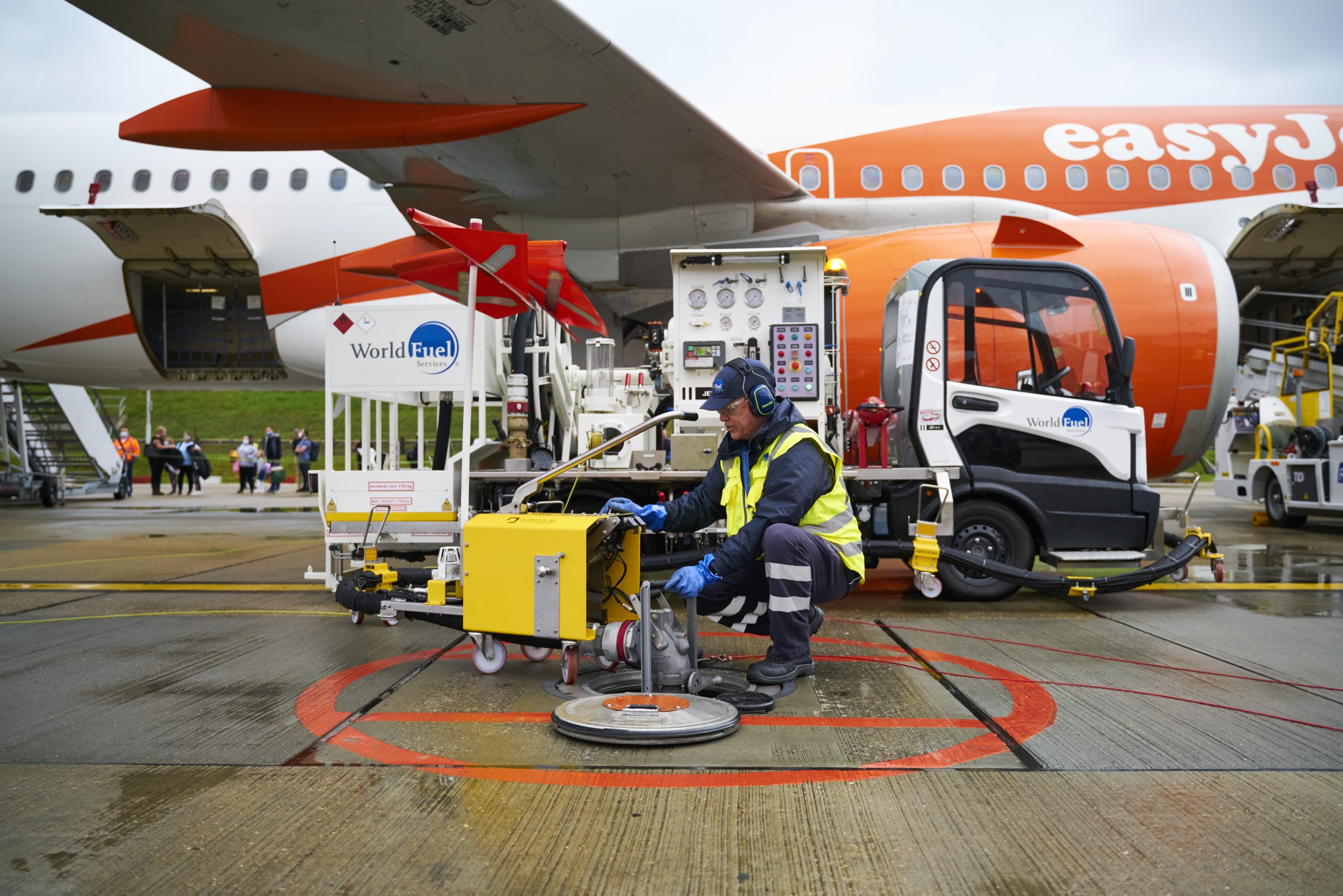Reaching net zero for direct carbon emissions before 2040
- Like
- Digg
- Del
- Tumblr
- VKontakte
- Buffer
- Love This
- Odnoklassniki
- Meneame
- Blogger
- Amazon
- Yahoo Mail
- Gmail
- AOL
- Newsvine
- HackerNews
- Evernote
- MySpace
- Mail.ru
- Viadeo
- Line
- Comments
- Yummly
- SMS
- Viber
- Telegram
- Subscribe
- Skype
- Facebook Messenger
- Kakao
- LiveJournal
- Yammer
- Edgar
- Fintel
- Mix
- Instapaper
- Copy Link
Posted: 15 March 2022 | Tim Norwood | No comments yet
In a UK-airport first, Gatwick’s new electric forecourt will support VINCI Airport’s sustainability targets. Tim Norwood, Director of Corporate Affairs, Planning and Sustainability at London Gatwick Airport, explains more.


As a member of VINCI Airports’ network, we act as a team across 53 airports in 12 countries to improve passenger experience, innovation, and sustainability. On the field, we are always looking to enhance and improve how we work at Gatwick by increasing efficiency, making the passenger journey as seamless and enjoyable as possible, and cutting our carbon emissions.
Climate change is one of the most important issues facing society, not just aviation, and is something that must be tackled head on.
An increasing number of passengers are looking closely to see how the aviation industry is actively reducing its environmental impact, before booking their tickets, so it is vital the sector can demonstrate clear action in this area. My department works closely with colleagues in Gatwick and across VINCI Airports network to develop and implement initiatives to lessen our environmental impact.
By 2019, we reduced our overall carbon emissions by 54 per cent (vs. 1990) through a range of energy and fuel efficiency initiatives and the purchase of 100 per cent renewable electricity, and we hold Airport Carbon Accreditation at Level 3+ ‘Neutral’ for direct emissions.
Our target is to increase airport passenger and staff usage of public transport and zero and ultra-low emission journey modes to 60 per cent by 2030″
This was achieved through a wide range of measures including providing fixed electrical ground power on all aircraft stands, by installing electric charging facilities in our car parks, increasing the use of electric vehicles and by sending zero untreated waste to landfill for the fifth consecutive year.
As a member of the global network of VINCI airports, we are not resting on our laurels however, and continue to look for new and innovative solutions to help us transition to our goal of reaching net zero carbon emissions for the airport’s direct emissions before 2040, and for aircraft emissions by 2050.
Zero or ultra-low emission vehicles
Increasing the number of on-airport vehicles that meet zero or ultra-low emission standards is one way we plan to achieve this and that’s why in December 2021, we were delighted to announce a partnership with GRIDSERVE, which will see Gatwick become the first UK airport to host an electric forecourt.
This is the net zero equivalent to a petrol station, where users of electric vehicles will be able to recharge on-site, with facilities available while they wait, such as a café, waiting lounge with free superfast Wi-Fi, convenience supermarket, children’s play area, toilets, and a dedicated educational space to increase awareness around electric vehicles.


Towards the end of 2021, easyJet flew the first commercial aircraft from Gatwick using SAF. Credit: London Gatwick Airport (LGW)
The electric forecourt will be located at Gatwick’s South Terminal close to the M23 – a major motorway linking London to major towns and cities down to, and along, the UK’s south coast. This makes it convenient whether a Gatwick passenger, staff member, local resident, or business is looking to introduce electric vehicle fleets, or for EV users simply passing by, en-route to, and from, London or the wider region. As such, the electric forecourt will have an impact beyond the airport perimeter.
Users of electric vehicles will be able to recharge on-site, with facilities available while they wait, such as a café, waiting lounge with free superfast Wi-Fi, convenience supermarket, children’s play area, toilets, and a dedicated educational space to increase awareness around electric vehicles”
It will enable 36 electric vehicles to be charged simultaneously, with high-power chargers that can deliver up to 350kW of charging power, capable of adding 100 miles of range in less than 10 minutes. Multiple charging connectors will cater for all types of electric cars. The initiative supports the plan to accelerate installation of EV charging facilities right across VINCI’s global network of 53 airports in 12 countries across Europe, Asia, and the Americas.
Building work is already well underway and we expect to have the forecourt available for public use by the autumn of 2022. As with all GRIDSERVE’s chargers, the site will also be supplied with 100 per cent renewable energy generated by GRIDSERVE’s own solar farms.
RELATED NEWS:
Gatwick to further its net zero journey with an Electric Forecourt
Gatwick Airport plans to reopen South Terminal in March 2022
Supporting and increasing public transport use
Supporting and increasing public transport use is another way we plan to reach net zero for the airport’s emissions. Contributing to this are initiatives such as the multi-million-pound development of Gatwick Airport railway station, which will relieve crowding, improve accessibility, and reduce delays for international passengers, commuters, and leisure travellers across the southeast.
The works will see the station concourse double in size, increasing capacity and, importantly, creating more space for passengers to enjoy a more pleasant experience.
Customer access will also be improved through five new lifts, eight new escalators, new stairways, and improved wayfinding throughout, assisting wheelchair users and passengers with bulky luggage.
Alongside improved access, by widening platforms passengers will be able to board and alight trains faster and more safely, reducing delays on the network.
We hope all of this will contribute to making rail the travel method of choice for passengers travelling to Gatwick, as we seek to improve on our record year of 2019, during which almost half of Gatwick passengers travelled to the airport by rail, bus, or coach. Our target is to increase airport passenger and staff usage of public transport and zero and ultra-low emission journey modes to 60 per cent by 2030.


Gatwick will be the UK’s first airport to host an electric forecourt. Credit: London Gatwick Airport (LGW)
Aligning with VINCI Airport’s plans to demonstrate environmental leadership and be the first to deliver new ideas, Gatwick is also contributing funding to support the purchase of a fleet of hydrogen-fuel cell powered buses by Metrobus – a local bus service provider. The move will effectively convert many key local bus routes into, and out of, Gatwick Airport into zero-emission services when they start later this year (2022).
Local carbon offsets
Gatwick is also looking at developing local carbon offsets and is providing funding over the next three years to support the South Downs National Park Authority in developing new local carbon offset products from farmland regeneration in the local area.
Our objective is that after 2025 we will start to purchase local carbon removal credits alongside international offsets, as part of our net zero before 2040 goal, and by doing so we also hope to support the growth of a broader carbon removal industry in our region.
Net Zero – aircraft emissions
Both the UK – including Gatwick – and international aviation sectors, including the global network of VINCI airports that Gatwick is part of, have committed to reaching net zero carbon for aircraft emissions, which have an impact beyond our airport perimeters, by 2050, through a range of measures including sustainable aviation fuels (SAF).
Towards the end of 2021, easyJet flew the first commercial aircraft from Gatwick using SAF and they were followed shortly after by a new airline to Gatwick – Eastern Airways – who launched their new service to Cornwall using SAF.
Simultaneously, easyJet also introduced an electric hydrant dispenser, provided by World Fuel Services, at Gatwick – the first in the UK – to further decarbonise its operations at the airport. This is serving the airline’s fleet of 71 aircraft at Gatwick and adds to the electric ground services equipment already supporting easyJet aircraft operations at Gatwick Airport.
Speaking more broadly, our plans also feed into our majority shareholder, VINCI Airports’, global environmental action plan. This plan seeks to develop carbon-free energy for passengers and users, and is the first in the industry to be applied to a network of 45 airports in 12 countries.
We hope to be able to welcome you all to Gatwick in 2022, whether it’s to make use of our electric forecourt, our fantastic public transport services or to catch a flight to one of our exciting destinations.
Biography


Issue
Related topics
Aircraft, Airport development, Airside operations, Emissions, Passenger experience and seamless travel, Passenger volumes, Sustainability, Sustainable Aviation Fuel (SAF), Sustainable development, Terminal operations, Workforce
Related airports
Related airlines
Related organisations
Airport Carbon Accreditation (ACA), Airport Council International (ACI), GRIDSERVE, South Downs National Park Authority, VINCI Airports


















